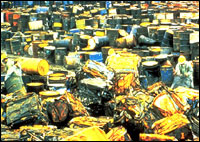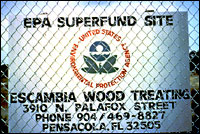Arsenic in water, mercury emissions, new-source review, Dick Cheney’s energy task force — these are the issues that have elicited the loudest howls of protest about the Bush administration’s environmental record during the past three years. By comparison, the grumbling over Superfund has been remarkably muted.

Mountains of toxic waste dot the horizon around Tar Creek.
Photo: U.S. EPA.
But lately the grumble has risen to a growl. In mid-April, Time ran a feature by Margot Roosevelt entitled “The Tragedy of Tar Creek,” which exposed what it called “eco-assault on an epic scale.” The article looked at a neglected Superfund site that has led to widespread lead poisoning, among other scourges, in a nearby Oklahoma community — where “Little League fields have been built over an immense underground cavity that could collapse at any time. Acid mine waste flushes into drinking wells … [and] neon-orange scum oozes onto the roadside. Wild onions, a regional delicacy tossed into scrambled eggs, are saturated with cadmium.”
It’s one thing to lament this particularly egregious case; it’s another to accept that the Tar Creek tragedy is just one of many Superfund screw-ups. As Roosevelt’s article pointed out, Tar Creek can be counted among 29 other cleanup projects in 17 states that stalled out because they were underfunded by the U.S. EPA last year, according to the agency’s inspector general’s office.
Since President Bush took office, the Superfund program’s budget has decreased by 25 percent in inflation-adjusted dollars, and some 50 percent fewer sites have been cleaned up, according to a report produced by the Sierra Club and the U.S. Public Interest Research Group Education Fund. In fiscal year 2003, the Bush administration completed cleanups at only 40 Superfund toxic-waste sites, whereas an average of 87 Superfund cleanups were completed per year between 1996 and 2000.
Industry representatives and Bush officials argue that these numbers are misleading because many of the easiest-to-tackle Superfund sites were cleaned up early in the program’s history, leaving behind bigger, more complex sites that take longer to deal with. Environmentalists counter that so-called “mega-sites” have been part of the agency’s agenda for decades, and the shortfall is due to meager funding and a flimsy commitment to the Superfund cause.

A waste site that helped spur the creation of Superfund.
Photo: U.S. EPA.
“The Bush administration has watched the Superfund program dwindle to a shadow of itself. It’s in the worst shape since it was passed by Congress in 1980,” said Grant Cope, an environmental attorney who specializes in toxic waste. “The data unequivocally show that there has been a dramatic slowdown in the pace of cleanups at the nation’s worst toxic-waste sites and a reduction in the number of new sites that EPA is listing as eligible for cleanup. Both problems are due to gross deficiencies in funding.”
Granted, this is partly attributable to circumstances that pre-date the Bush administration. In 1995, the GOP majority in Congress refused to reauthorize a tax levied on polluting industries that supplied the grubstake for the Superfund and enabled the EPA to clean up contaminated sites even if the costs were too high for a polluting company to handle. That tax hasn’t been renewed since.
Then again, the Bush administration is the first ever to argue against the tax and refuse to advocate for it on the Hill; moreover, the administration has made only meager efforts to replenish the fund by other means. Although the White House did request an increase in Superfund allocations for fiscal year 2004, which Congress refused to grant, “it was clear their request was placed at the bottom of their list of priorities,” said Cope. “Over and over again, this is an administration that has proven it can force its priorities through Congress. Superfund is simply not a priority.”
But while the Bush administration has been remiss on the funding front, it did make an effort to shape the future of Superfund through creating a subcommittee under the EPA’s National Advisory Council for Environmental Policy and Technology (NACEPT). After 22 months of investigation and debate, and more than 1 million in taxpayer dollars to fund the deliberations, the subcommittee released its report [PDF] in mid-April with recommendations for the Superfund program. That report got virtually no media coverage, other than a brief mention in the Time article as the reason that Superfund advocates are “bracing for a new battle.”
“While the [subcommittee] process highlighted the need to address serious problems with the Bush administration’s implementation of the program, the report was biased, unacceptable, and off the mark,” said Cope, one of the subcommittee’s 32 members. So unacceptable did he find its recommendations, in fact, that he was one of five subcommittee members who refused to sign the final document. Other dissenters included representatives from the Sierra Club, the Center for Public Environmental Oversight, the New Jersey Department of Environmental Protection, and the Mineral Policy Center (now known as Earthworks).
Chief among their concerns was that the report’s conclusions disproportionately represented the interests of an industry-stacked panel: “Two-thirds of committee members represented the interests of PRPs [potentially responsible parties] — corporations responsible for toxic-waste sites listed on [Superfund’s] National Priorities List,” said Vicky Peters, a subcommittee participant from the Colorado attorney general’s office. “Not just executives, but people who have a stake in the PRPs — scrap recyclers, lobbyists, insurers, legal reps, developers. These are all people who have liabilities or who represent companies with liabilities.”
Not surprisingly, the industry-heavy committee blocked any recommendations that would increase funding for the Superfund program — presumably for fear that it would empower the EPA to issue more administrative orders forcing them to pony up cleanup funds.
“It got ugly,” Cope told Muckraker. “During deliberations there were strained discussions between the members. There were people yelling in the room, pointing fingers. It was not a pretty sight. Some of us came out of that process pretty bruised up.”
Industry folks agreed that the atmosphere was contentious and were hesitant to comment on the subcommittee’s deliberations. “I’m very guarded about discussing this,” Lindene Patton, vice president and counsel for the insurance company Zurich Specialties, told Muckraker. “The funding discussion in particular got heated, very politicized in my opinion. It took on a life of its own.”
Another committee member, Sue Briggum, a longtime lobbyist for Waste Management and now director of environmental affairs for the company, expressed similar sentiments: “You’d have to be dead not to realize how politicized these issues are right now in election year. I’m cautious about discussing this because the issues can be spun in ways I’m not comfortable with — like the claims by some that the ‘polluter pays’ principle has gone out the window. That’s patently untrue.”

Sign qua non.
Photo: U.S. EPA.
While it’s true that roughly 70 percent of all Superfund cleanups are paid for directly by the polluters, some 30 percent are so-called orphan sites that have either been abandoned or that polluters don’t have the funds to deal with. That’s where the polluter tax comes in: The pooled tax revenues from chemical-producing and polluting industries pay for orphan-site cleanups as well as for oversight on the other projects. But with the tax no longer being collected, mom-and-pop taxpayers are stuck with the bill. In 2004, taxpayers are expected to pay more than $1 billion for Superfund cleanups — roughly 300 percent more than they paid for the program in 1995, according to a U.S. PIRG analysis.
Industry argues that the polluter tax is unfair because “it flies in the face of individual accountability. It’s just generic accountability,” says Briggum. “Should a company help pay for a contaminated site even if they didn’t contaminate it, just because they are part of an industry — or should general revenues be used? I don’t think it’s self-evident who it ought to be.”
To environmentalists (and even to the Reagan and Bush I administrations, which supported the polluter tax), the logic was clear enough. As Cope explains it, “If industries are earning profits off the sale and use of products that contaminate the environment, they are more directly associated with [the consequences] than taxpayers.”
In March, Senate Democrats lost an effort to reinstate the polluter tax by only seven votes. That prompted the Sierra Club to air TV spots in swing states with a “Make Polluters Pay” slogan, and on tax day, enviros protested at post offices in 25 states to drive the issue home to taxpayers.
Still, industry-oriented members of the subcommittee managed to keep a funding recommendation out of the NACEPT report entirely, arguing that money is Congress’ domain and the subcommittee should focus on the way Superfund is managed, a matter that the EPA can directly control.
Environmentalists decried this effort to pass the buck: “Well, if the EPA isn’t going to ask Congress for money, who the heck will?” asked Cope.
According to Velma Smith, a Superfund specialist at National Environmental Trust who sat in on a number of the subcommittee meetings, the General Electric representative Jane Gardner (referred to by some as “G.E. Jane”) didn’t just dismiss the funding problem, she denied it altogether: “According to my notes, Gardner said she was ‘totally opposed [to] and cannot live with any recommendation for more money,'” Smith told Muckraker. “She further added the even more preposterous comment that ‘This program is well funded and always has been.'” Gardner did not return Muckraker’s calls.
Midway through the subcommittee deliberations, when it became apparent that members would never reach consensus on most major issues, EPA gave up on that approach and advised the members to submit a range of views. Problem is, the range of views were mostly published without attribution, and many that came from industry could weaken Superfund’s protections. “The final conclusions drawn in the report totally lacked accountability, and basically gave [industry’s unattributed recommendations] as much legitimacy and weight as the consensus recommendations,” said Jessica Frohman, a Sierra Club toxic-waste specialist who served as an alternate representative on the subcommittee.
Every dissenter who refused to sign the report agreed that its first major flaw was the failure to acknowledge the need for a significant, stable funding source and to even entertain the idea of reinstituting the tax on polluting industries. The program’s dire funding shortages were even acknowledged in an internal EPA report quietly posted on the agency’s website this week, although no real funding solutions were proposed. Among the range of recommendations that dissenting subcommittee members found problematic was the notion that sites be added to Superfund’s National Priority List based on EPA’s budgetary constraints, weighing the financial viability of site cleanups instead of focusing on how much of a threat sites pose to public health. Even more alarming to some was the suggestion that sites be cleaned up based on their potential to be redeveloped for commercial purposes — a proposal that would disadvantage the cleanup of sites in rural communities and inner-city areas, which are generally less favorable markets for commercial development.
“The most discouraging thing that came out of this committee meeting is that it could change the fundamental mission of Superfund,” said Frohman. “This was a program developed first and foremost to protect human health, to save lives. These recommendations have the potential to turn it into a program contingent on expenses and affordability, rather than protecting public health.”
Cope also has concerns about the report’s potential ramifications: “If the Bush administration gets reelected, I think that … officials could use [the report] to weaken the program — either to change the statutory language or undertake more subtle administrative reforms. And the report would give them political cover to do so.”
These concerns loom large when you consider that one out of every four Americans lives within four miles of a Superfund site, according to the General Accounting Office. That translates into 73 million Americans who could be at risk of floating down Love Canal if Superfund continues to be neglected.

